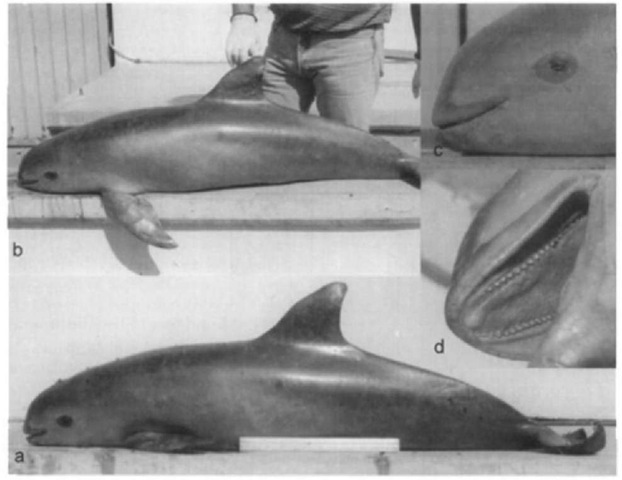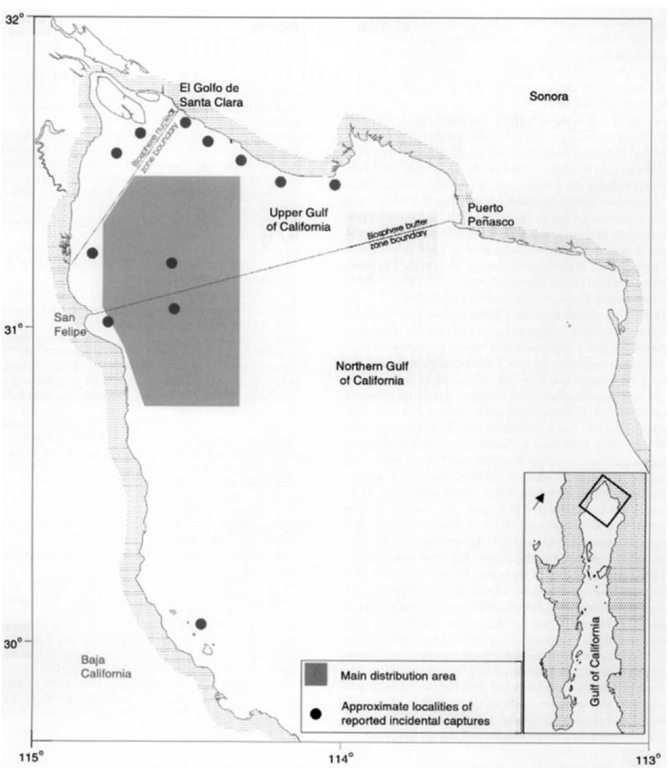The vaquita (Phocoena sinus Norris and McFarland, 1958), or Gulf of California harbor porpoise, is endemic to the Gulf of California. It is also one of the two most endangered cetacean species in the world (Jefferson et al., 1993). The vaquita is a relatively new species. It was described in 1958 (Norris and McFarland, 1958). However, it was not until the past decades that important advances were made in our knowledge of this highly endangered porpoise.
I. Description, Characters and Taxonomic Relations
The vaquita is the smallest of all the porpoises. The mean length for females is 140.6 cm, whereas males are slightly smaller (134.9 cm). The vaquita differs from other phocoenids not only in total length, but also in that the flippers of the vaquita are proportionately larger and the dorsal fin is taller and more falcate. Generally, the pigmentation pattern is a dark gray cape, pale gray lateral field, and white ventral field. The most conspicuous features of the pigmentation are the relatively large black eye rings and lip patches (Fig. 1). Skulls of adult vaquitas are smaller and have relatively much broader and shorter rostra than those of other members of the genus. The number of tooth pairs in the upper and lower jaw is 16-22 and 17-20, respectively (Brownell et al., 1987; Vidal et al, 1995). Norris and McFarland (1958) suggested that the vaquita diverged from P. spinipinnis rather than from Phocoena phocoena, its closest geographic phocoenid neighbor. This hypothesis was corroborated almost 37 years later by Rosel et al (1995) using molecular techniques.
II. Abundance, Distribution, and Ecology
The limited abundance, distribution, and narrow habitat specificity of vaquita make it one of the rarest marine mammal species. The most recent published population size estimate by Jaramillo-Legorreta et al. (1999) was 567 individuals (CV = 0.51, 95% CI 177-1073). All sightings from systematic ship surveys indicate that its distribution is limited to an area north of 30°45′N (Silber et- al, 1994; Gerrodette et al, 1995; Vidal, 1995; Jaramillo-Legorreta et al, 1999) specifically to a portion of the upper Gulf of California (see Fig. 2). This is probably the most restricted distribution of any marine cetacean. Vaquita habitat can be described as a region characterized by strong tidal mixing, convection processes, high turbidity, high nutrient concentration, and primary and secondary productivity. In this environment, most vaquita sightings have been in waters 11^50 m deep, 11 to 25 km from the coast, and over silt and clay bottoms (Silber et al, 1994; Gallo and Torre, 1998). It is known that vaquitas move to the eastern coast of the upper Gulf, mainly from recovered specimens (beached and bycaught) and not so much from sightings (Vidal et al, 1999).
Analysis of stomach contents of 34 vaquitas reveals them to be nonselective feeders (Findley et al., 1995; Perez-Cortes, 1996). Prey consisted primarily of a wide variety of demer-sal/benthic fishes (21 species), squid (2 species), and crustaceans (1 species, plus 2 that were fish parasites). Several of the fish prey species (such as croakers, Scianidae) are known to be sound producers so it is possible that vaquitas are frequently using passive sound rather than echolocation to find their prey.
III. Life History and Behavior
The only published paper on the fife history of the vaquita is that by Hohn et al. (1996). Arguably the most striking aspect of this work is the unusual age distribution of the vaquita. Most individuals (62%) were found to be between 0 and 2 years of age. The remainder of individuals (31%) were between 11 and 16 years of age, with few specimens determined to be between 3 and 10 years. There was a complete absence of individuals between the ages of 3 and 6 years.
The sample of animals may be biased due to spatial segregation of different age classes or the susceptibility of various ages to be captured in nets. Alternatively, if this were the true age distribution of the population, this would represent a complete recruitment failure in recent years.
Figure 1 Morphology of the vaquita. (a and b) Lateral views. Note proportionally large dorsal and pectoral fins, (c) Lateral view of the head showing the dark patches surrounding the eye and lips, (d) Ventral view of the mouth showing the palate and the spade-shaped crown of teeth.
Like other porpoises, the vaquita is a seasonal reproducer, with most births occurring around March. There are no data, but gestation is probably 10-11 months, as with other porpoises. The maximum observed life span is 21 years, which is consistent with the maximum life span of the harbor porpoise, Phocoena phocoena. Age of sexual maturity is difficult to estimate because of the lack of juvenile animals in the sample, but all females less than 3 years were immature and all females older than 6 years were mature. Most female harbor porpoises mature at age 3 and give birth first at age 4, which is consistent with these observations for the vaquita. Reproductive rates could not be estimated accurately, but unlike harbor porpoises in the Gulf of Maine, vaquitas are probably not annual reproducers.
No pathological study of the recovered specimens has been published. However, morphological abnormalities in the vertebrae, unusual number of digits (six), and pathological condition of the ovaries (calcification of corpora albicantia) have been reported (Ortega-Ortiz et al., 1993; Torre-Cosio, 1995; Holm et al, 1996).
Little is known of die social organization of die vaquita. Mean school size is two, but groups as large as 8 or 10 individuals have been reported. An important aspect is die loose aggregating behavior. The dynamics of diese group aggregations are not clear. However, it seems diat either dieir duration is short or they shift locations in short periods of time. For example, Jaramillo- Legorreta et al (1999) reported 41 vaquita groups loosely aggregated over several hundred square meters. During the next days and couple of weeks later, diis group aggregation was not found. There are also indications that suggest that shrimp trawlers are related to this aggregating behavior (Jaramillo-Legorreta et al, 1999).
The vaquita, like other phocoenids, has the capacity to produce narrow band high-frequency clicks (Silber, 1991). The primary use of this sound must be echolocation, although its role in communication could be important in the turbid and dynamic environment of the Upper Gulf of California. Evidence indicates that the clicking rate is lower for the vaquita than for the harbor porpoise. The shallow waters inhabited by the vaquita can be a reason for this, as vaquitas can be looking for prey visually at the bottom for longer periods. Further acoustical studies can reveal areas with differential ecological uses by the vaquita.
IV. Conservation Status
The vaquita is classified in the most critical conservation categories by the International Union for the Conservation of Nature (IUCN, 1996), Convention on International Trade in the Endangered Species of Wild Fauna and Flora (1997), and the Mexican government (Norma Oficial Mexicana, DOF 16 de Mayo, 1994). In 1996, the IUCN concluded that the extinction of the vaquita is likely unless conservation efforts are increased substantially.
Figure 2 The Upper Gulf of California. The core area of distribution (gray) was sketched from sightings data. Solid circles represent localities where bycaught vaquitas have been reported.
To protect the vaquita and other endangered species, the Mexican government created the Upper Gulf of California and Colorado River Delta Biosphere Reserve on June 10, 1993. However, as new knowledge of the vaquita has been gained, it is clear that this measure is insufficient. Results of the surveys in 1993 and 1997 indicate that the boundaries of this biosphere reserve do not correspond well to the distribution of vaquitas. A large percentage of the sightings (40%) lie outside the reserve boundary (Fig. 2). Further, no sightings were within the nuclear zone of the reserve, which is the area where all fishing is prohibited (Gerrodette et al, 1995; Jaramillo-Legorreta et al, 1999).
A more specific action has been the creation of the International Committee for the Recovery of the Vaquita (CIRVA) by the Mexican government. Recognized scientists from the United Kingdom, Canada, the United States, and Mexico participate in CIRVA. The mandate of this group is to propose a recovery plan based on the best available scientific information. The plan should also contemplate and consider the socioeconomic impacts of any required regulations on the resource users in the affected areas.
During its first meeting, CIRVA concluded that in the short term, gill nets are die greatest risk to the survival of die vaquita. Estimated incidental mortality in gill nets is 39-84 vaquitas per year (D’Agrosa et al, 2000). This represents from 6 to 14% of the current population size estimate and is from only one fishing port. The committee agreed that inbreeding depression, chlorinated pesticide concentrations in the Upper Gulf, and reduced flow from the only freshwater input (die Colorado River) are not risk factors at present (Taylor and Rojas-Bracho, 1999; Rojas-Bracho and Taylor, 1999). It also agreed, however, that, in die long term, changes in vaquita habitat due to reduction of the Colorado River flow are matters of concern and must be investigated.
During the second meeting, CIRVA evaluated the potential mitigation measures: seasonal closures of specific areas, gear restriction, acoustic deterrents, and marine-protected areas.
After analyzing these measures, CIRVA strongly recommended that vaquita bycatch should be reduced to zero as soon as possible, the southern boundary of the biosphere reserve should be expanded to include the entire range of the vaquita, and gill net and trawlers should be banned in the enlarged biosphere reserve. CIRVA recognized that these protective measures would have significant impacts on the resource users of the Upper Gulf of California and, therefore, it was not possible to implement full protection immediately. Therefore, it was recommended that gill net fishing in the areas inhabited by vaquitas be removed in three stages, starting with large-mesh gill nets. Considering this, CIRVA strongly recommended investigating die development of strategies to offset economic hardship imposed by these regulations.
Other recommendations were the effective enforcement of fishing regulations; that acoustic surveys be started immediately to begin monitoring an index of abundance and gather data on seasonal movements of vaquitas; development and testing of alternate gear types to replace gill nets; the design and development of community involvement, education, and public awareness programs; and a description of the critical habitat of vaquita.
Finally, CIRVA recommended inviting the international community and nongovernmental organizations to provide technical and financial assistance to implement the conservation measures to recover this highly endangered porpoise.


